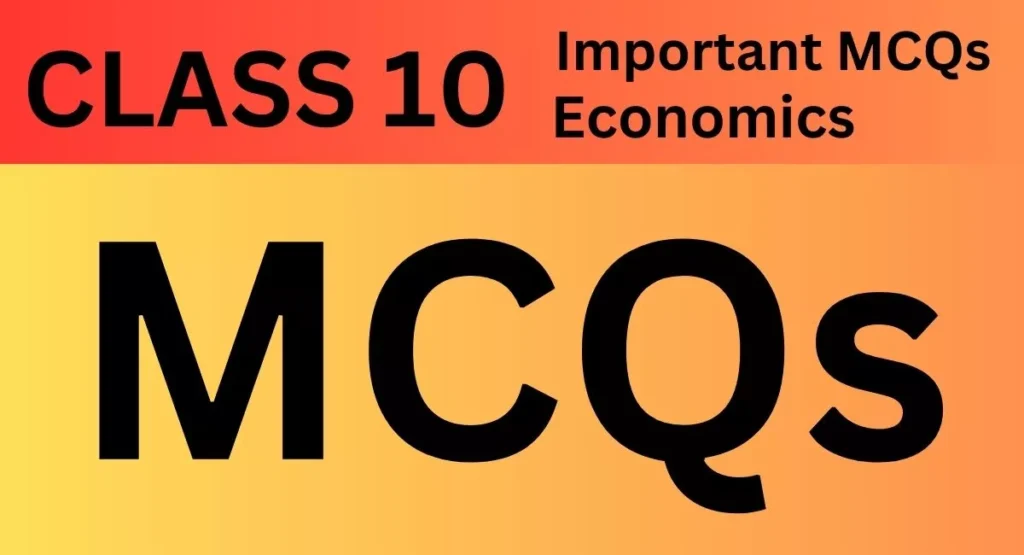Are you a student of class 10th and you are looking for MCQs Class 10 Economics Chapter 3 ? Because this chapter is very important for the exam. Many questions from this chapter have come in the exam. Because of this, it is very important to know the question and answers of this chapter.
So students, after reading this article, you will get a lot of marks from this chapter in the exam, because the questions related to all the exams have been described in it, so definitely read it completely.
Important MCQs Class 10 Economics Chapter 3 Money and Credit
| class | Classes | 10th |
| CHAPTER | Chapter | 03 |
| Chapter Name | Chapter Name | Money and Credit |
| board | board | CBSE |
| book | Books | NCERT |
| subject | Subject | ECONOMICS |
| Medium | Moderate | ENGLISH |
| Study Material | Study Materials | MCQs |
Money and Credit

MCQs
1 When was the new economic policy made?
(a) 1918
(b) 1920
(c) 1919
(d) 1991
The name of the central bank in India is.
(a) Indian Bank,
(b) State Bank of India,
(c) Central Bank,
(d) Reserve Bank of India.
The main function of the Reserve Bank of India is-
(a) grant of loans,
(b) Dealing with the World Bank,
(c) credit control,
(d) none of these
Nationalization of Reserve Bank of India
(a) 1st April, 1947.
(b) 1st April, 1948,
(c) 1st April, 1949,
(d) 1st April, 1960.
The system of exchange of goods for goods is called-
(a) barter system,
(b) Exchange system,
(c) Monetary system,
(d) Credit system.
In which exchange system is double coincidence of wants an essential feature?
(a) Monetary economy,
(b) Barter system.
(c) Global economy,
(d) none of these
| class 10th Notes | MCQ |
|---|---|
| History | Political Science |
| English | Hindi |
| HOME | CLASS 10 |
7 Who issues currency notes in India?
(a) State Bank of India,
(b) Central Bank of India,
(c) Reserve Bank of India,
(d) Punjab National Bank.
8 Formal sources of credit do not include-
(A) Bank
(b) the employer,
(c) co-operative society,
(d) All of these
9 Which of the following is a formal source of credit for poor rural households?
(a) Merchant,
(b) Zamindar,
(c) Commercial Bank,
(d) moneylender
10 Which of the following is an example of plastic currency?
(a) cheque,
(b) draft,
(c) credit card,
(d) Demand draft.
11 Which of the following currency is adopted in India?
(a) dollar,
(b) pound,
(c) EURO,
(d) Rs.
12 Informal sources of credit include
(a) trader,
(b) co-operative societies,
(c) Bank
(d) none of these
13 Banks in India keep what percentage of the total deposits in the form of cash?
(a) 10%, .
(b) 12%,
(c) 15%,
(d) 20%.
14 a countryHow many central banks are there in
(A) 1
(b) 3,
(c) 1.
(d) 5.
15 The primary function of currency is–
(a) medium of exchange,
(b) Measurement of value,
(c) transfer of value,
(d) Distribution of national income.
16. The terms of credit do not include-
(a) rate of interest,
(b) Supporting Indebtedness,
(c) cheque,
(d) Mode of payment.
17 What is the main source of income for banks?
(a) interest on loans,
(b) interest on deposits,
(c) the difference between the interest charged on borrowers and that on depositors,
(d) none of these
18 Which of the following is not a condition involved in taking a loan?
(a) rate of interest,
(b) pro-lending,
(c) documents,
(d) the land of the debtor.
19 Which of the following is not a function of money?
(a) Measurement of value,
(b) accumulation of value,
(c) transfer of value,
(d) Stabilization of price.
